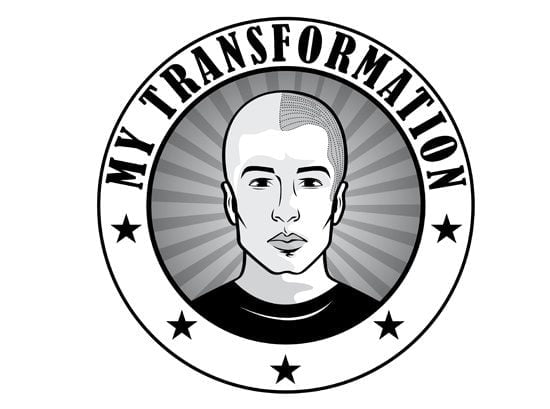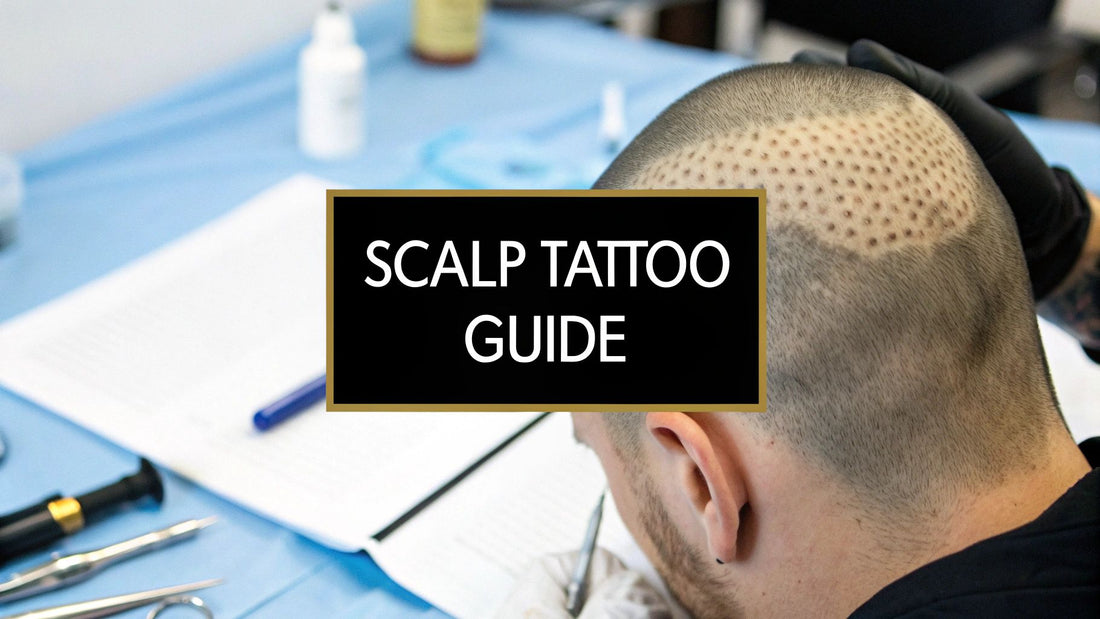
Your Guide to the Scalp Tattoo in Australia
Share
You've probably heard of cosmetic tattoos for eyebrows and lips, but what about for your scalp? It's a game-changer for anyone dealing with hair loss. Known professionally as Scalp Micropigmentation (SMP), this non-surgical treatment cleverly uses micro-needles and specialised pigments to create the look of thousands of tiny, natural hair follicles.
The end result? It can create the illusion of a full, sharp buzz-cut or cleverly mask thinning patches within longer hair, giving you the appearance of a much denser head of hair.
How Scalp Tattoo Works
So, how does it actually happen? A highly skilled practitioner uses a device with ultra-fine needles to deposit thousands of minuscule dots of pigment into the upper layer of your skin. Think of it like artistic pointillism for your scalp.
Up close, they're just tiny dots, but from a normal distance, they blend together to perfectly replicate the look of natural hair follicles. Every pigment is custom-blended to match your specific hair colour and skin tone for a seamless finish.
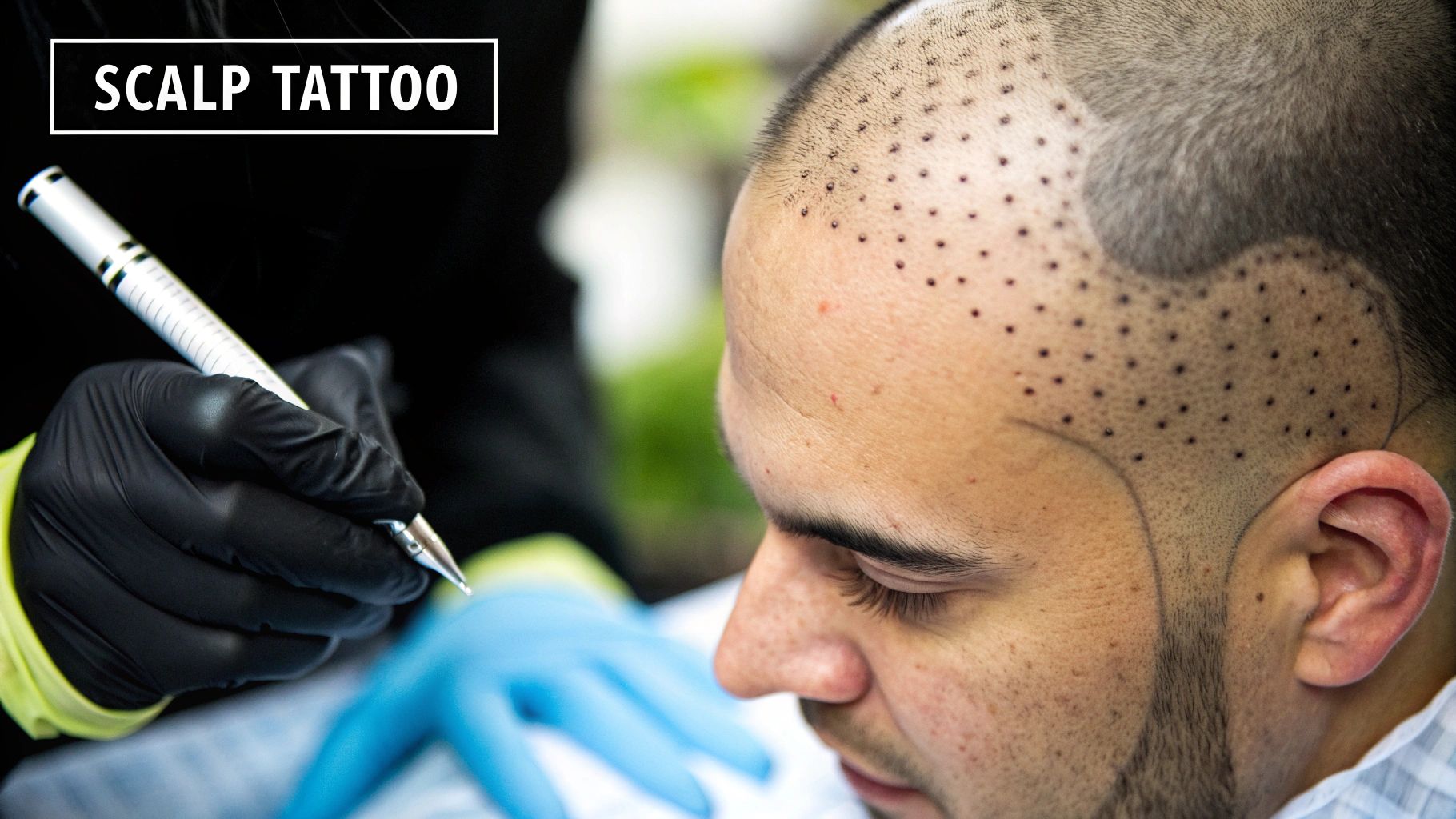
Here’s a quick breakdown of the technique:
- The micro-needles only penetrate the skin at a very shallow depth, creating crisp, defined impressions that don’t blur.
- The pigments are specifically designed to resist fading and won't turn an odd colour over time.
- The entire look is built up over multiple sessions, layering the pigment gradually to achieve a completely natural and realistic density.
Key Components of Scalp Tattoo
The needle depth for SMP is typically just 1 to 2 millimetres—much shallower than a regular body tattoo. This is crucial as it minimises skin trauma and allows for much quicker healing between sessions.
The goal of SMP is to recreate hair follicles with pinpoint accuracy, offering a low-maintenance solution for hair loss.
If you’re worried about permanence, SMP pigments are actually designed to fade very gradually over several years. This controlled fading is a good thing, as it makes touch-ups simple and ensures the colour doesn't migrate or change hue, keeping it looking natural for years to come.
Real-World Growth of Scalp Tattoo in Australia
Over the last decade, scalp tattooing has really taken off in Australia as a trusted and effective hair loss treatment. It's part of a bigger trend, too. The McCrindle report found that 25% of Australians now have at least one tattoo, a jump from 19% in 2016 and 20% in 2018.
Within that growing market, SMP has found its niche, becoming a popular choice for older adults and women looking for a non-surgical way to tackle thinning hair or baldness.
Want to dive deeper? Check out our detailed guide on the topic.
Why Scalp Tattoo Is Different From Traditional Tattoos
It’s easy to think SMP is just a tattoo on your head, but the technique is worlds apart. Traditional tattoos penetrate deeper into the skin and use inks that can blur or change colour (often turning bluish or greenish) over time.
SMP avoids this entirely by using those specialised pigments and a much shallower needle depth. Practitioners use purpose-built tools that give them incredible control over each dot's size and placement, which is absolutely essential for creating a result that's indistinguishable from your real hair.
Comparing Treatment Zones
SMP can be tailored to address specific areas of concern.
| Zone | Purpose |
|---|---|
| Hairline | To define the shape and beautifully frame the face. |
| Crown | To build up density right where thinning is often most noticeable. |
| Scar Areas | To expertly camouflage and blend in marks from surgery or injuries. |
Depending on your pattern of hair loss, a session might focus on one or more of these zones. Your practitioner will work with you during the consultation to set clear goals and ensure the final coverage is exactly what you envisioned.
Next Steps For Beginners
Getting started is a straightforward process. Here’s what you can expect:
- Consultation: This is where you'll discuss your goals, and the practitioner will assess your skin and hair loss pattern.
- Pigment Matching: A custom shade is mixed to blend perfectly with your existing hair colour.
- Test Patch: A small, discreet test is often done to see how your skin takes the pigment.
- Initial Session: The first layer of dots is applied to create the foundation of your new look.
- Follow-Up: After a week or two of healing, you’ll come back for a second session to add more density and refine the shape.
Remember, proper aftercare is key to a great result
The Scalp Tattoo Procedure: A Step-by-Step Guide
So, you're thinking about a scalp tattoo. It's an exciting prospect, but it’s completely normal to wonder what the process actually involves. Knowing what to expect from start to finish can take the mystery out of it and help you feel confident as you move forward. The whole journey is carefully planned, usually over several weeks, to build up a result that looks incredibly natural and heals perfectly.
It all kicks off with a simple chat. Your first consultation is probably the most critical part of the entire process. This is where you and your practitioner really get on the same page. It’s much more than a quick hello; it's a deep dive into what you want to achieve, making sure a scalp tattoo is the best solution for you.
We'll talk about the exact hairline you’re after—maybe something sharp and strong, or perhaps a softer, slightly receded look for a more natural appearance. Your artist will also take a close look at your skin and mix custom pigments to get the perfect shade that matches your skin tone and any remaining hair. This teamwork is what makes the final look so seamless and convincing.
Laying The Foundation for a Great Result
The consultation really sets the stage for everything that follows. A great practitioner will never rush this part. They know that a clear, detailed plan is the blueprint for your new look and is essential for success.
This image breaks down the key parts of that initial planning phase.
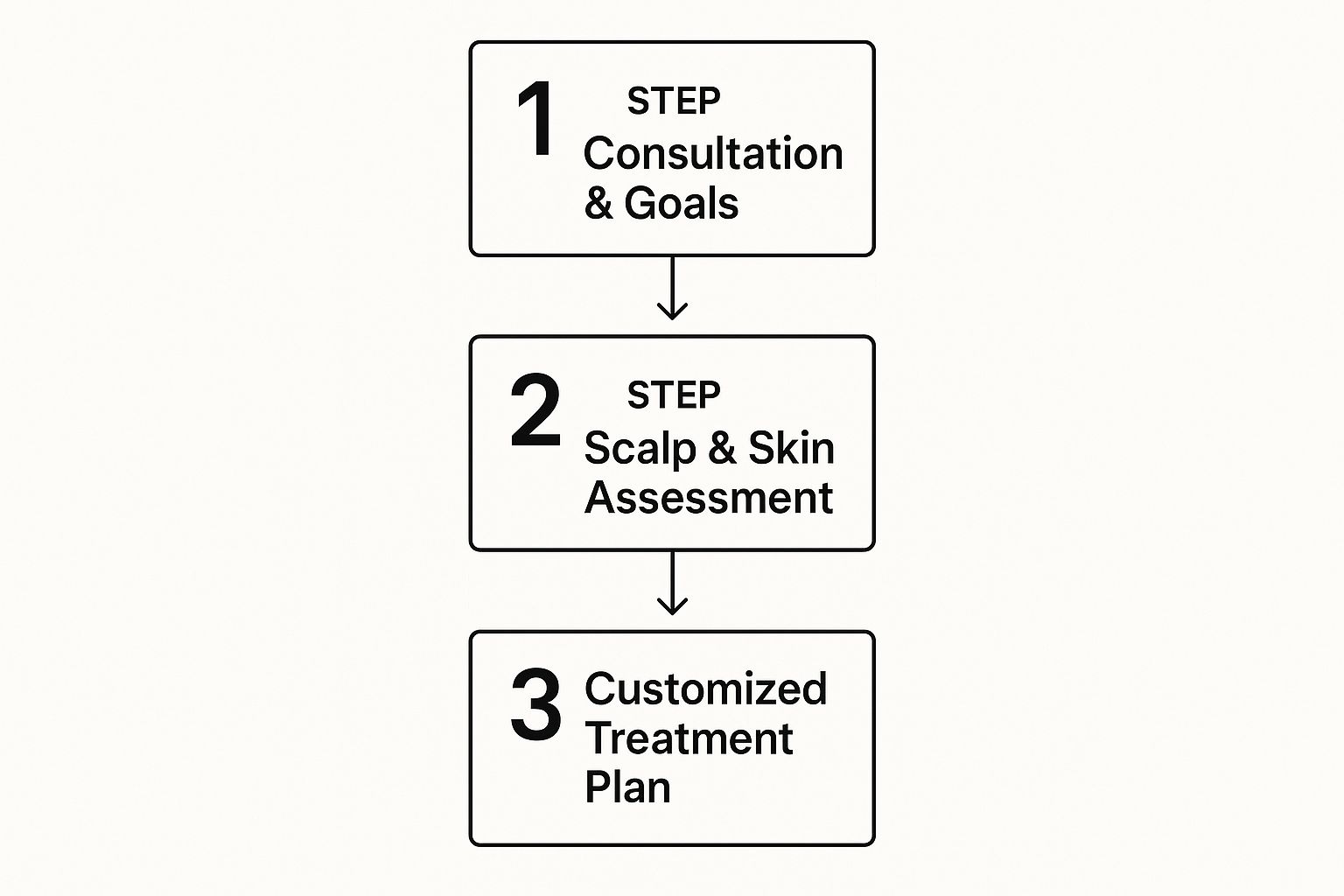
As you can see, a successful scalp tattoo is built on understanding your goals, a professional assessment of your scalp, and a treatment plan that’s tailored just for you.
What Happens During the Treatment Sessions?
A complete scalp tattoo isn’t a one-shot deal. The real artistry happens over a series of 2 to 3 sessions. Each session can last anywhere from two to four hours, depending on the size of the area we’re working on. We schedule these appointments about 10 to 14 days apart to give your skin ample time to heal.
Here’s how it typically unfolds:
- First Session: This is where we lay the groundwork. Your practitioner will apply the first layer of impressions, often with a slightly lighter pigment. The main goal is to establish your new hairline and create a soft, even base across the entire treatment area.
- Second Session: Now it’s time to build density. Your artist will add thousands more tiny follicle impressions in between the ones from the first session. A slightly darker shade is often introduced here to start creating that realistic illusion of depth and texture.
- Third (and Fourth) Session: These are all about perfection. We use this time to fill in any final gaps, make tiny adjustments to the hairline, and ensure the blend between the tattoo and your existing hair is absolutely seamless.
Think of it like a painter adding layers to a canvas. By gradually building up the density over multiple sessions, the practitioner creates a multi-tonal, three-dimensional look that perfectly mimics the appearance of real hair follicles.
Most people find the sensation quite manageable, rating the discomfort at about a 2-4 out of 10. It’s definitely less intense than a regular body tattoo. The healing time between sessions is non-negotiable; it lets the pigment settle into the skin, showing the artist exactly how your scalp is taking the colour. This guides the approach for the next appointment.
While this multi-session process is the industry standard for the best results, for some candidates, an intensive one-day SMP session hair tattoo might be an option.
Who Is an Ideal Candidate for Scalp Tattoos
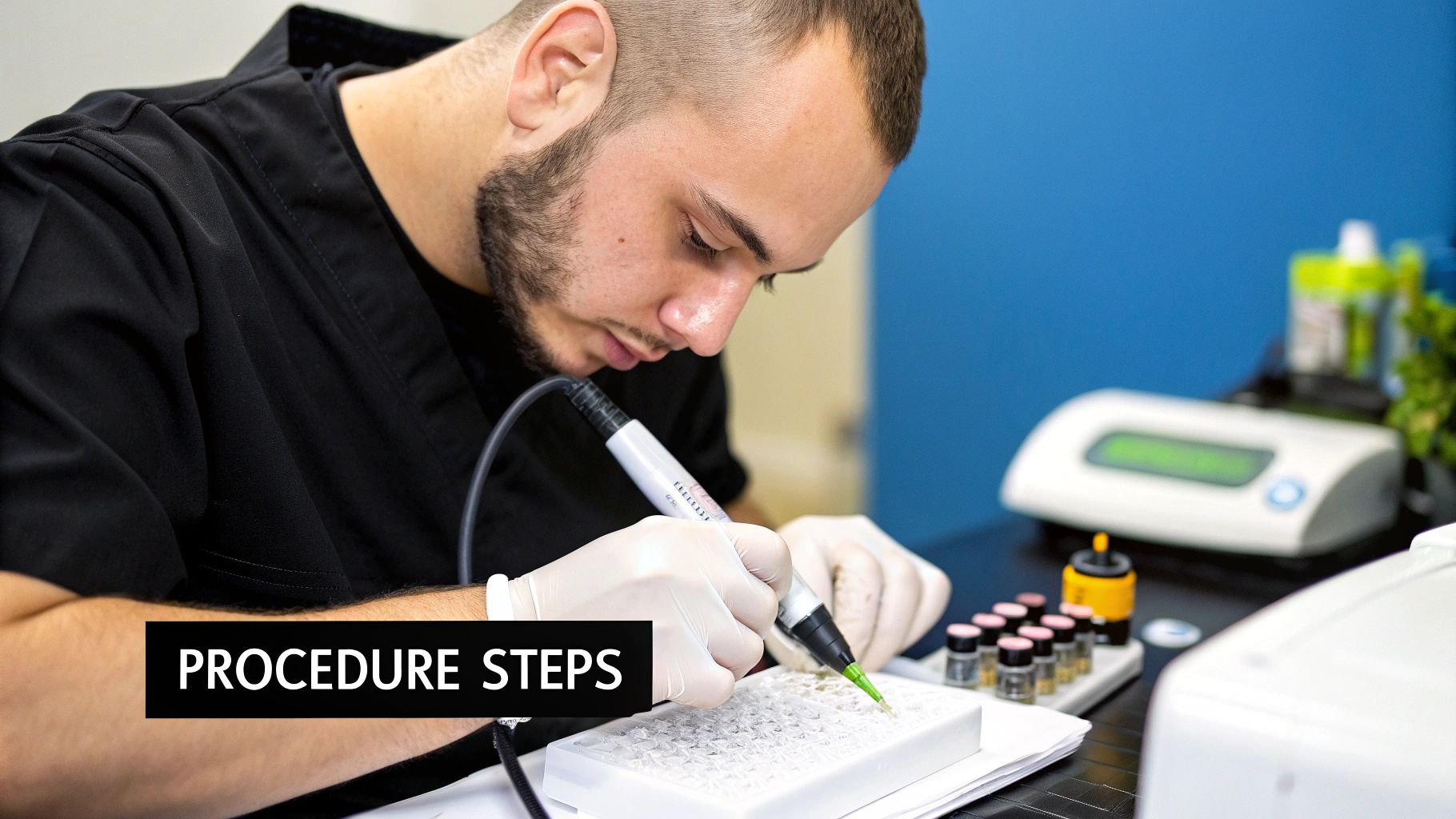
Figuring out if a scalp tattoo is the right move for you is about more than just wanting to see more hair. It's really a matchmaking process—aligning what the treatment can do with your specific type of hair loss, your day-to-day life, and what you want to see in the mirror. While Scalp Micropigmentation (SMP) is incredibly versatile, it truly shines in certain situations.
The real beauty of SMP lies in its adaptability. It’s not a one-size-fits-all product but a detailed, artistic procedure. So, let's break down who stands to gain the most from it.
H3: Those Seeking the Clean Buzz-Cut Look
This is the classic application for SMP, and for good reason. If you're dealing with significant hair loss, like advanced male pattern baldness (think Norwood scale 4 and up), a scalp tattoo can be a complete game-changer. By meticulously replicating thousands of tiny follicles, the treatment creates the permanent look of a sharp, full buzz-cut.
It’s the perfect solution for men who are done with trying to hide bald spots and are ready to embrace a strong, clean, and ridiculously low-maintenance style. SMP completely erases the old horseshoe pattern, restores a natural-looking hairline, and frames the face in a way that often looks more youthful.
H3: Individuals with Thinning Hair
You don't need to have major hair loss to see huge benefits from SMP. For both men and women experiencing diffuse thinning—where the hair loses density all over—a scalp tattoo can work wonders. The procedure essentially adds a "shadow" to the scalp, which dramatically reduces the harsh contrast between your skin and hair.
By carefully placing pigment between existing hairs, a skilled practitioner creates an illusion of greater density and fullness. This makes the scalp less visible through the hair, giving your existing hair a much thicker and healthier appearance without any surgical intervention.
This approach is becoming increasingly popular among women. With female pattern hair loss affecting up to 40% of women by age 50, many women in Australian cities like Melbourne and Sydney are turning to SMP. It’s a non-invasive way to restore visual density and confidence almost immediately.
H3: People with Alopecia
Alopecia is an autoimmune condition that causes unpredictable patchy or total hair loss, which can be incredibly tough to deal with. SMP offers a reliable and powerful way to manage the cosmetic side of things. For those with alopecia areata (patchy hair loss), the treatment can fill in the bald spots, making them blend seamlessly with the surrounding hair.
For individuals with alopecia totalis (total scalp hair loss), SMP provides a complete solution, creating the appearance of a full head of hair styled in a buzz-cut. This can bring back a sense of control and normalcy that is truly empowering. You can get a much deeper look into this specific use case in our guide on scalp micropigmentation for alopecia.
H3: Camouflaging Scars and Imperfections
Scars on the scalp, whether from an old injury, surgery, or a dated hair transplant procedure like Follicular Unit Transplantation (FUT), can make you feel self-conscious. A scalp tattoo is an excellent tool for camouflage.
A skilled artist can meticulously deposit pigment into and around the scar tissue. This technique breaks up the scar's appearance and helps it blend into the surrounding scalp, making it far less noticeable. It gives you the freedom to wear your hair short without a second thought.
Scalp Tattoo Suitability for Different Hair Loss Types
To give you a clearer picture, here’s a quick breakdown of how SMP works for various hair loss conditions.
| Hair Loss Condition | Effectiveness of SMP | Primary Goal Achieved |
|---|---|---|
| Male Pattern Baldness | Excellent | Creates a full buzz-cut look; restores hairline |
| Diffuse Thinning | Excellent | Adds density; reduces scalp visibility |
| Alopecia Areata | Very Good | Fills in bald patches to blend with existing hair |
| Alopecia Totalis | Excellent | Creates a complete and realistic buzz-cut appearance |
| FUT/FUE Transplant Scars | Excellent | Conceals and camouflages scar tissue effectively |
| Receding Hairline | Very Good | Rebuilds a stronger, more defined hairline |
This table shows just how flexible SMP can be, offering a solid solution for everything from adding a bit of density to a full scalp restoration.
H3: Who Might Not Be a Good Candidate
While SMP is a fantastic option for many, it isn't the right fit for absolutely everyone. Here are a few situations where you might need to reconsider or wait:
- Active Skin Conditions: If you have active psoriasis, eczema, or severe acne on your scalp, it’s best to wait until the condition is calm and in remission.
- Keloid Scarring: Anyone with a history of forming keloid scars (thick, raised scars) may not be a suitable candidate due to the risk of the tattoo causing them.
- Unrealistic Expectations: It’s crucial to remember that SMP creates a 2D illusion of hair follicles. It's a highly advanced cosmetic tattoo, not a treatment that makes hair grow back.
Many people look into scalp tattoos as part of a broader strategy to tackle hair loss. If you're exploring different avenues, you might also find some helpful information on supplements for hair loss. Ultimately, the best way to know for sure is to have a chat with a qualified practitioner who can assess your scalp and help you figure out if a scalp tattoo is right for you.
The Real Cost of a Scalp Tattoo in Australia
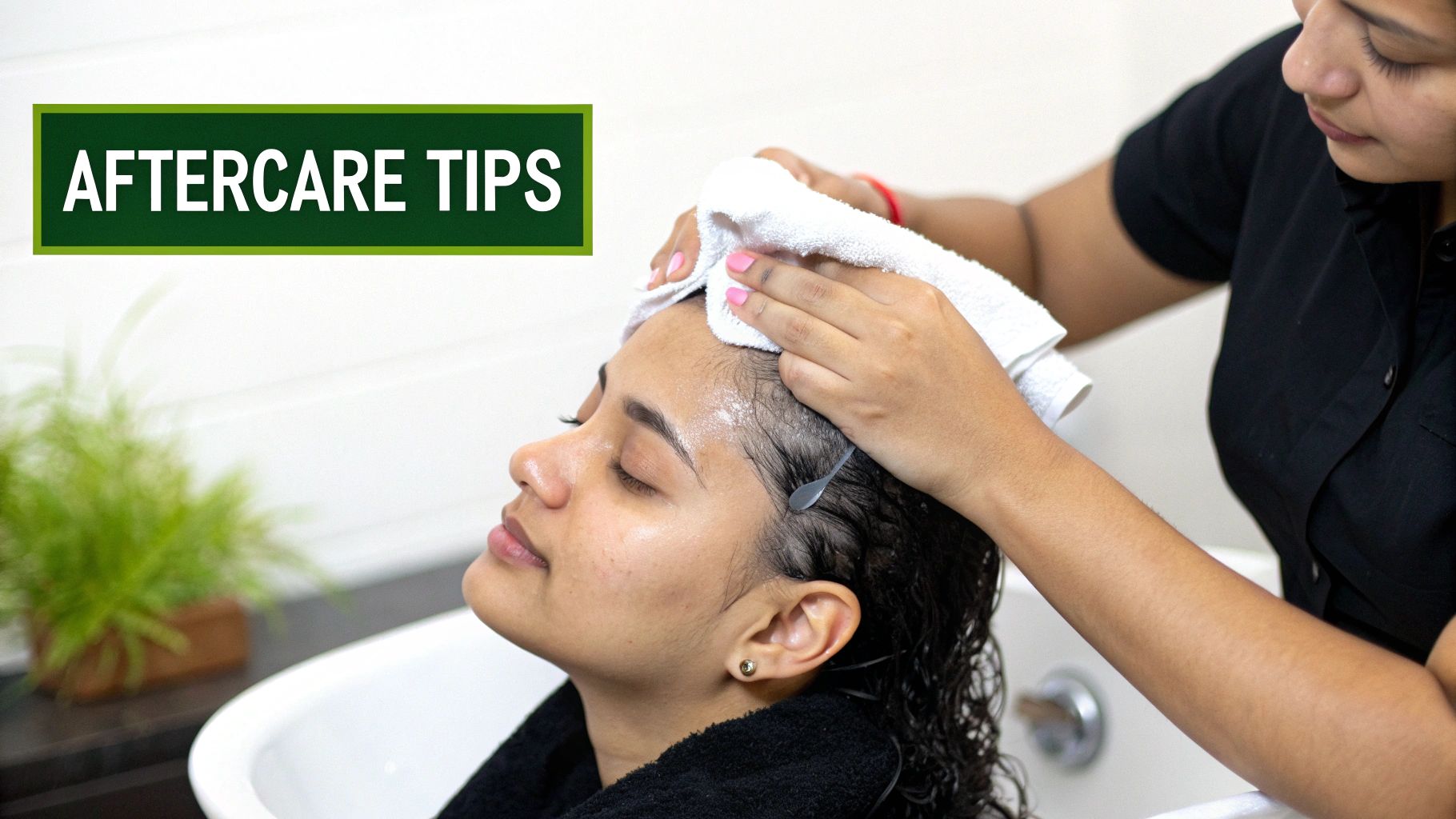
Let's get straight to the point. When you’re thinking about getting a scalp tattoo, one of the first questions is always about the price. It's a completely fair question, but the answer isn't a simple one-size-fits-all figure.
The cost is as personal as the treatment itself. Think of it like getting a custom suit made – the final price depends on the specific work needed to get the perfect fit for you.
Key Factors That Determine The Price
So, what actually goes into the final quote? A good practitioner will always walk you through a clear breakdown during your consultation, so there are no surprises.
It really boils down to a few key things:
- Area of Coverage: This is the big one. Are you looking to add some density to a thinning crown, or do you need a full hairline rebuild and coverage across the top of your head? The more scalp we need to cover, the more time and work is involved.
- Hair Loss Stage: We often use the Norwood scale as a guide for male pattern baldness. Someone at a Norwood 2 (just a bit of recession) is a much quicker job than someone at a Norwood 7 (very extensive hair loss), and the price will reflect that.
- Practitioner Expertise: Like any skilled trade, experience matters. A highly seasoned artist with a fantastic portfolio and years of refined technique will naturally command a higher fee. You're paying for their artistry and the guarantee of a top-tier result.
- Geographic Location: The cost of running a clinic in the heart of Sydney or Melbourne is different from a smaller city. Clinic overheads and local market rates can play a part in the final cost.
Typical Cost Ranges In Australia
To give you a ballpark idea, let's talk numbers. For smaller jobs, like filling in a slightly thinning patch or touching up a small area, you could be looking at somewhere between AUD $500 and $1,200.
If you're dealing with more noticeable hair loss, the cost generally sits in the AUD $1,500 to $2,600 range. For extensive work covering significant baldness, the investment might be anywhere from AUD $2,600 up to $3,400 or more. And for specialised work, like camouflaging scars from a hair transplant, prices are often between AUD $1,200 and $1,880.
We break this down even further in our guide to scalp micropigmentation costs.
It's worth seeing a scalp tattoo not just as a cost, but as a long-term investment in your confidence. When you stack it up against the endless cycle of paying for hair systems or topical treatments, the value really starts to shine through.
SMP Versus Other Hair Loss Solutions
When you compare the numbers, the long-term financial sense of SMP becomes very clear. A hair transplant, for instance, is a serious surgical procedure that often starts at $10,000 and can easily go much, much higher.
Then you have topical foams or prescription medications. These aren't one-off costs; they are a constant drain on your wallet, month after month, for years on end. Over a lifetime, that really adds up.
A scalp tattoo is different. It’s a one-time investment that, when looked after properly, can last for years before needing a simple, inexpensive touch-up. It's a remarkably cost-effective way to get your confidence back.
Essential Aftercare and Long-Term Maintenance
Getting a scalp tattoo is a massive step forward, but the job isn't quite finished when you walk out of the clinic. Protecting your new look is just as vital as the procedure itself, and it all boils down to smart aftercare and consistent long-term habits.
Think of it this way: the artist creates the masterpiece, but you're the one who has to preserve it. Following the right steps ensures the pigment settles perfectly, your scalp heals cleanly, and your results stay sharp for years to come. We can split this into two parts: what to do right after your treatment, and the routine you'll need for the long haul.
The First Few Days: Your Immediate Aftercare Plan
The first week after each SMP session is without a doubt the most critical healing period. Your scalp is sensitive, and the fresh pigment needs time to settle into the skin properly. Being gentle during this phase isn't just a suggestion—it's essential for getting the result you paid for.
Your practitioner will give you a detailed list of instructions, but the main rules are pretty straightforward.
-
Days 1-3: The golden rule is simple: do not touch, wash, or get your scalp wet. That also means no heavy sweating, so you'll need to skip the gym, saunas, or any intense exercise. You need to let those tiny micro-wounds close up so the pigment can set.
-
Day 4: Okay, you can finally give your scalp its first gentle wash. Use lukewarm water and a mild, sulphate-free shampoo. Don't scrub at it; just let the water run over your head and lightly pat it dry with a clean, soft towel.
-
Day 5 and Beyond: You can now continue with gentle daily washes. It's also crucial to avoid direct, prolonged sun exposure for at least the first month. If you have to be outside, a loose-fitting hat is your new best friend.
The goal during this initial phase is simple: create the perfect healing environment. Minimising irritation, moisture, and UV exposure allows each tiny pigment deposit to heal crisply, ensuring the sharp, defined look of a natural hair follicle.
Long-Term Care: Keeping Your Scalp Tattoo Vibrant
Once your final session has fully healed (which usually takes about a month), your focus switches from healing to preservation. The great news is that long-term SMP maintenance is surprisingly easy, but you have to be consistent. There's one enemy that stands above all others when it comes to the longevity of your treatment.
That enemy is the sun. The ultraviolet (UV) rays from the sun are the number one cause of pigment fading over time. Just like sun can fade a regular tattoo or damage your skin, it will gradually lighten your scalp tattoo.
To keep your results looking fresh, you need to make sunscreen a daily habit.
- Choose a High SPF: Go for a broad-spectrum sunscreen with at least SPF 30+. For the harsh Australian sun, SPF 50+ is an even better choice.
- Find a Matte Finish: Plenty of modern sunscreens are made for the face and scalp, offering a non-greasy, matte finish so your head doesn't look shiny.
- Apply Daily: Make it part of your morning routine, rain or shine. UV rays cut straight through clouds, so you need protection every single day.
For a deeper dive, check out our 5 top tips to care for your scalp after SMP.
While sticking to the standard aftercare is crucial, some people look into other methods to help with healing. If you're curious about reducing post-procedure inflammation, looking into options like red light therapy for inflammation relief could provide some interesting insights.
Planning for Touch-Ups
A scalp tattoo is considered semi-permanent. Even with the best aftercare in the world, the pigment will naturally soften and lighten over several years. Don't worry—this is a completely normal part of the process.
On average, most clients pop back in for a touch-up session every 4 to 6 years. This is a much quicker and more affordable appointment than your initial treatment. It’s simply a refresh, where the artist adds a new layer of pigment to bring back the original colour depth and definition, making your scalp tattoo look brand new again.
Common Questions About Scalp Tattoos
Deciding to get a scalp tattoo is a big step, and it's totally normal to have questions buzzing around your head. Beyond the basics of the procedure and the cost, there are those day-to-day practicalities that everyone wonders about.
This is where we get into the nitty-gritty. We'll talk about everything from what it feels like in the chair to how it holds up years down the track, clearing up any final doubts so you can move forward with confidence.
Is a Scalp Tattoo Painful?
This is usually the first thing people ask, and the answer is almost always a pleasant surprise. For the vast majority of clients, it’s more of a minor annoyance than real pain. On a scale of 1 to 10, most people put the sensation somewhere between a 2 and 4.
It's a world away from the feeling of a traditional body tattoo. The specialised needles are incredibly fine and only just break the surface of the skin, unlike the deeper work of a regular tattoo. To make sure you’re comfortable, your practitioner will almost always apply a strong topical numbing cream to your scalp before they even begin.
Most people describe it as a light, consistent pricking or a bit like an electric razor grazing the skin. You’ll probably find that some spots, like your temples or front hairline, are a little more sensitive than others. But honestly, any discomfort is usually most noticeable during the first session and fades as you get used to the feeling in later appointments.
How Long Does a Scalp Tattoo Last?
Think of a scalp tattoo as semi-permanent. The results are incredibly long-lasting, but they aren't meant to be forever like a traditional tattoo. Over several years, you’ll notice the specialised pigment gradually and very subtly soften in colour.
This slow fade happens for a few key reasons:
- Sun Exposure: UV rays are the number one factor that will affect how long your treatment lasts.
- Your Immune System: Over a long time, your body naturally breaks down the tiny pigment particles.
- Your Skin Type: Things like how oily or dry your scalp is can also make a difference.
On average, you can expect your scalp tattoo to look sharp and fresh for 4 to 6 years. After that, a simple touch-up session is all you’ll need. This is just a short, less expensive appointment to refresh the pigment, bringing back that original depth and making it look brand new again.
A touch-up isn't a sign that the treatment has failed; it's just planned maintenance. The best thing you can do to keep your results looking vibrant for longer is to practice diligent, long-term care—especially by using a quality sunscreen on your scalp every single day.
Will a Scalp Tattoo Look Fake or Obvious?
When it’s done right by a skilled professional, a scalp tattoo should be completely invisible to the naked eye. The real goal is to create a look so hyper-realistic that it’s impossible to tell the difference between pigment and actual hair follicles, even up close.
The secret to this undetectable finish comes down entirely to the artist's skill and meticulous attention to detail. A few things have to be perfect:
- Pigment Matching: Your artist needs to be an expert at blending pigments to create a custom shade that’s a perfect match for your natural hair colour and skin tone.
- Hairline Design: A great practitioner won't give you a ruler-straight hairline. They'll design a soft, slightly imperfect one that looks natural for your age and face shape.
- Dot Placement: Using specialised micro-needles, the artist has to replicate the random pattern, angle, and varying sizes of real hair follicles.
On the flip side, a poor job from an inexperienced technician can definitely look unnatural. Common giveaways are dots that are too big, a pigment colour that's off, or a harsh, drawn-on hairline. This is exactly why doing your research and choosing a reputable artist with a strong portfolio of work is the single most important decision you'll make.
Can I Grow My Hair After Getting SMP?
Absolutely. One of the best things about Scalp Micropigmentation (SMP) is that it doesn’t affect your hair follicles at all. You can still grow your hair just as you did before.
The pigment is placed in the upper layer of the dermis, which is well above the deeper level where your hair roots live. The procedure doesn't damage your existing follicles or stop new hair from growing. In fact, many clients get SMP specifically to create the illusion of more density under their thinning hair, allowing them to keep wearing it at a longer length.
And for those who get a scalp tattoo to rock that permanent "buzz cut" look? You'll just need to keep shaving or clipping your head every couple of days. This keeps the stubble from your real hair blended seamlessly with the tattooed follicles, ensuring the whole look stays sharp and consistent.
At My Transformation, Michael is dedicated to helping you find the perfect solution for your hair loss. If you're ready to explore how a scalp tattoo can restore your confidence, get in touch today. Learn more about our services and book your consultation at https://www.mytransformation.com.au.
